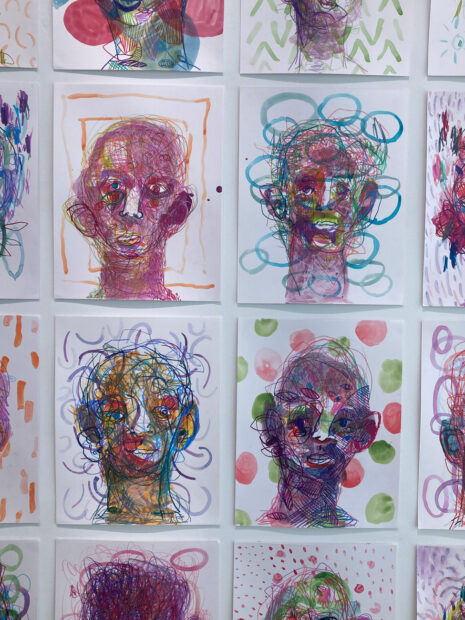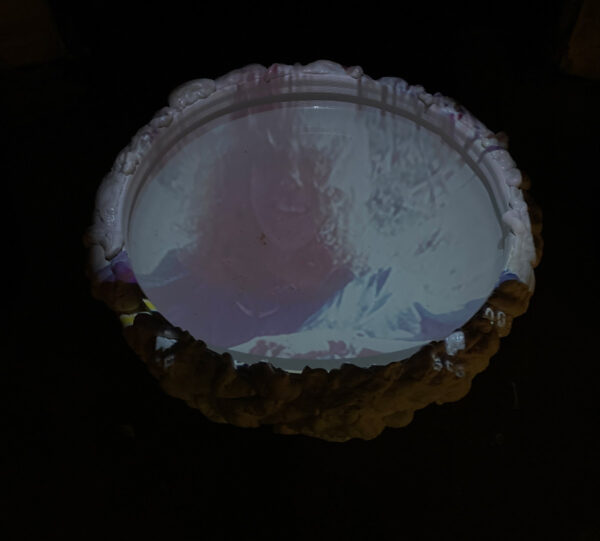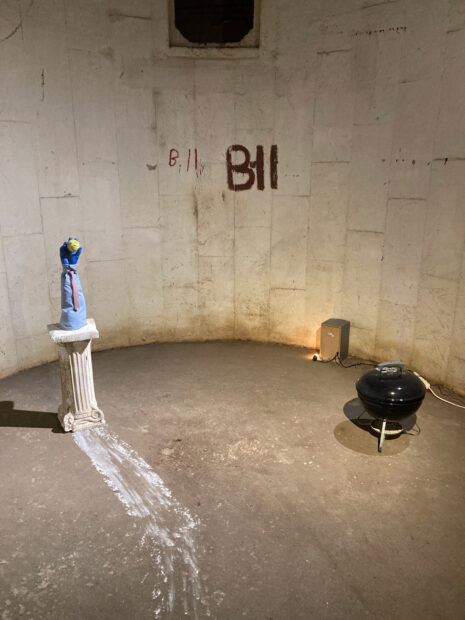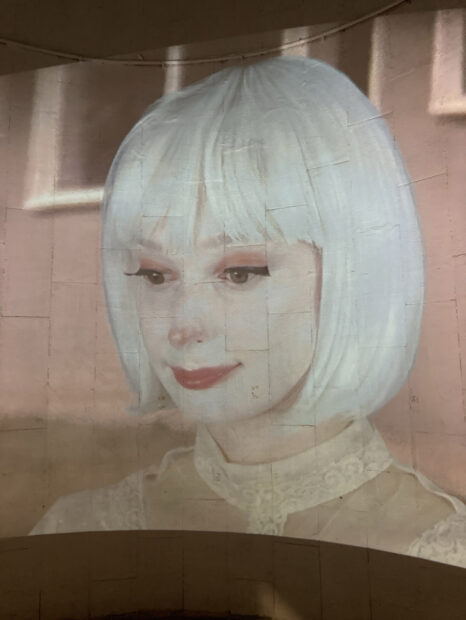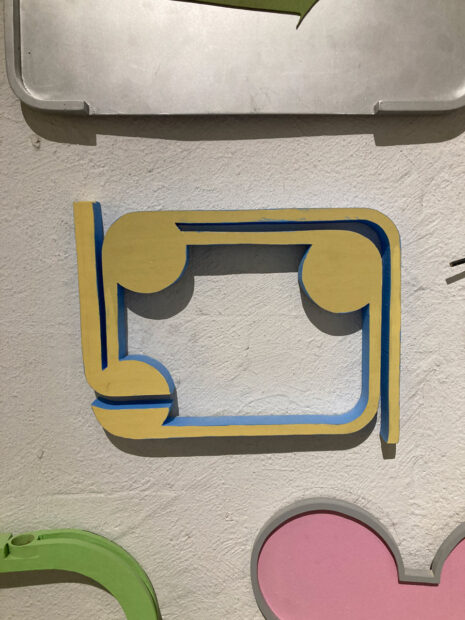Dallas
James Gilbert: I Don’t Know, You Don’t Know, They Don’t Know at Erin Cluley Gallery, October 8–November 12, 2022
In James Gilbert’s exhibition at Erin Cluley Gallery, one of the walls of the front gallery is pinned with drawings of over 130 faces. They are scribbled in a circular motion, until the linework accumulates into bald, androgynous heads in bold magentas and pinks. The installation fills the wall from edge to edge, and ominously peers over the sculptural works that sit on the floor in the center of the space. Their differences are slight, and they’re unique compositionally, such that they require close viewing to parse. There is an intimacy required in finding who these people are, somehow stripped of all ethnic or cultural signifiers.
I asked Gilbert to describe his thinking on drawing these portraits of humans, be they real or imagined: “We really don’t know more than three generations. We know our grandparents, we may know our great-grandparents, but we don’t know beyond that of our own family. So I’m using this as an education to say maybe we should know more about our history and our past.”
The process of creating the drawings lends itself to noticing and recognizing layers of familiarity. Gilbert went on to tell me, “The reason they’re so heavily drawn, to me, I’m making multiple generations in each drawing. That’s a family history in each drawing that I’m trying to get across.” The color palette and background is unique to each composition, which is an abstract nod to variations in the natural diversity of humanity’s gene pool. Collectively, the figures may all be related, or represent discreet family lines per drawing. Take the time to view them and see if you can spot any resemblances.
****
Houston
Synaptic: Sculptural Interpretations of Neural and Psychological Systems at SITE Gallery at the Silo at Sawyer Yards, October 8–December 3, 2022
Curated by Volker Eisele, this Sculpture Month Houston group exhibition pulls Texas sculptors together in the honeycomb-like former grain silos of SITE Gallery. Eisele was intent on organizing a show of works that explore the relationship between thoughts and tangibility; the things our brain can do despite our lack of understanding of how it works. “80,000 thoughts a day,” Eisele described to me of the human mind. “It’s just a frenzy of activity.”
A frenzy, indeed. Texas artists abound in this exciting, multimedia show. Christie Blizard’s opera Let My Body Eat the Sun is on view, which offers the Houston audience a chance to catch the seminal video work by the San Antonio conceptual artist. In Jeff Gibbons’ Hello, Goodbye, there is a portable grill with a spinning lid. An arm, still wearing a sleeve and its hand dyed blue, holds up a tennis ball which appears sentient thanks to incisions emulating eyes and a mouth. A track of a wailing voice plays in the background, somewhere between laughing and crying. This is, as usual, a sentimental and atmospheric presentation of one of Texas’ most inventive sculptors.
Hillary Holsonback’s Untitled, which draws from the artist’s Tan series, is a presentation of Holsonback’s fictitious personality. Tan, as seen in a 2020 exhibition at dallas contemporary, is known to stare blankly through the screen while offering quick messages of word salad, or incomplete thoughts.
Brad Tucker’s G A S (Gap Action Synthesizer) is a visual presentation of bits and bobs, painted shapes resembling the simple machines in our immune system which conjoin and reshape to create antibodies. Together, the work forms a maze of discovery and reflection, simulating what it is like to view art in Texas: frenzied, diverse, and challenging.
****

Alia Ali, “Leopard Sun,” pigment print on French produced Canson Baryta Photographique Baryta Matte Paper 310gr. with UV laminate mounted on aluminum Dibond in wooden frame upholstered on hand-dyed and hand-loomed Uzbek Baghmal silk velvet.
Alia Ali: Blue Note at Foto Relevance, September 9–November 12, 2022
Blue Note is comprised of several series of photographs in frames upholstered in the textiles featured in the images. Models are draped from head to toe in bright, busy paisley and floral-printed fabrics. On view here are works from Ali’s LIBERTY and IKATIKAT series, in which the models’ garb more closely resembles real garments; in previous works, Ali would take broad sheets and bunch them over the model, disfiguring the sitter into a jumbled mass. The real-life use of the same fabric, delicately affixed to the frames, adds an extra level of camouflage to the image.
In fashion, face coverings are sometimes meant as a comment on the difficulties of fame in contemporary society. Those in the highest echelons have the means for luxurious dress, but might prefer their identity to remain secret. In Ali’s photographs, the figure is kept secret, but their culture is displayed with vigorous straightforwardness. Exotic textiles, commodities of international trade, reveal their path through the colonial timeline while concealing those that dye, print, and craft that same cloth. Ali’s photographs are poignant investigations on respect for the subjects of colonization.
****

A scene fromVerónica Gaona’s performance “for those who do not return in life, there is always death/para aquellos que no regresan en vida, siempre está la muerte”
Verónica Gaona: for those who do not return in life, there is always death/para aquellos que no regresan en vida, siempre está la muerte at Lawndale Art & Performance Center, organized by DiverseWorks, October 14, 6:30 pm
For this performance, Verónica Gaona recruited a driver, Elijah Jimenez, to drive a Ford F-150 in a circle, stopping the truck periodically to spin its tires against the pavement and create large plumes of smoke. Audience members watched from the sidelines at the entryway garden of Lawndale, which hosted the event in its parking lot. The performance is in conjunction with Gaona’s two-person exhibition with Janelle Esparza, titled Sites of Memory, on view at DiverseWorks.

A scene fromVerónica Gaona’s performance “for those who do not return in life, there is always death/para aquellos que no regresan en vida, siempre está la muerte”
The performance’s title, in Spanish, was emblazoned on the rear windshield of the truck in gothic font. For the musical accompaniment, Gaona chose corridos, or ballads that tell a narrative about struggle. The truck’s bed was filled with a flower arrangement sponsored by Fannin Flowers, a local florist. “The flowers on the truck bed [are] being used because [they’re] an item that I use a lot in my work. It’s an item that symbolizes a funerary ritual that is practiced in families, migrant units. I’ve used them in real life, so I reimagined that in the truck bed,” Gaona told me. She then went on to describe a similar intention when choosing a vehicle for the performance, “It always had to be a Ford F-150 because that’s what my family has used [in] the years working abroad from the homeland in Mexico. Something that is really important about the truck is the tinted glass. Tinted glass for me [has] a sort of subverting power. This opaque glass is a way of protecting my family members, the Mexican diaspora.”
The procession of the truck at dusk was somber and short. It felt like a momentary acknowledgement of the family and the culture that is transmitted between the U.S. and Mexico. The rumination is not merely about loss, but about how translations are inherently imperfect.
****
William Sarradet is the Assistant Editor for Glasstire.
All photos by William Sarradet.


